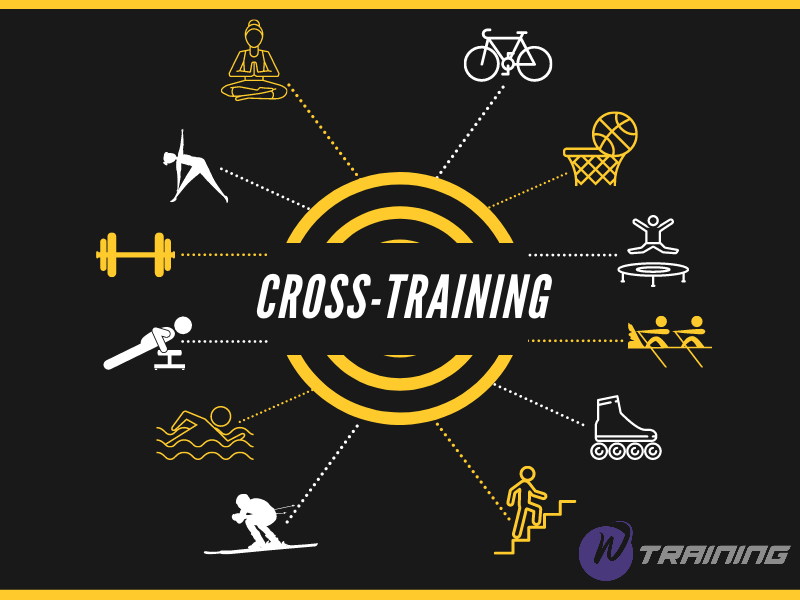In running or some sports, you often hear the term cross-training and are advised to do cross-training several times a week. Let’s figure out what exactly it is and how it affects your performance.
What is cross-training?
Cross-training is typically defined as an exercise regimen that uses several modes of training to develop a specific component of fitness.
Benefits of cross-training
Here are a few of the numerous documented benefits cross-training has to offer:
Reduced risk of injury
Individuals can exercise more frequently and for longer durations without overworking particularly vulnerable areas of the body by spreading the cumulative level of orthopedic stress over additional muscles and joints (e.g., knees, hips, back, shoulders, elbows and feet). People who are prone to lower-leg problems as a result of long-distance running should consider incorporating low-impact activities like elliptical training, cycling, and swimming into their routines. However, it should be noted that competitive cross-trainers can suffer from overuse injuries as a result of insufficient muscle rest, an unbalanced workout schedule, or both.
Enhanced weight loss
Individuals who want to lose weight and body fat should participate in an exercise program that allows them to burn a large number of calories safely. According to research, such a goal is best achieved when individuals exercise for relatively long periods of time (i.e., more than 30 minutes) at a moderate level of intensity (i.e., 60 percent to 85 percent of maximal heart rate). Overweight people can effectively lose weight and fat stores by combining two or more physical activities in a cross-training regimen. They can, for example, exercise for 20 to 30 minutes on an elliptical trainer and then cycle for another 20 to 30 minutes.
Improved total fitness
Cross-training activities can include both muscular fitness and aerobic conditioning. While an individual’s gains in muscular fitness will typically be less than if he or she only did strength training, the additional benefits of improving muscular strength and endurance can pay significant dividends. Resistance training, for example, has been shown in studies to help people avoid injury, control their weight, and improve their functional capacity.
Enhanced exercise adherence
According to research on exercise adherence, many people drop out of exercise programs because they become bored or injured. Cross-training is a safe and simple way to add variety to an exercise routine. In the process, it can help to promote long-term exercise adherence by lowering the risk of injury and eliminating or reducing the possibility of boredom.
See also: Running To Boost Your Immune System, Prevent Viral Infection
How to create a cross-training routine
The possibilities are endless when it comes to developing a cross-training routine. The goal is to choose exercises that require movements that are different from your preferred activity. Runners, for example, may want to incorporate racquetball, swimming, or weight training into their routine. A well-rounded option is to combine circuit training, sprinting, plyometrics, and other forms of skill conditioning, such as balance training.
Choose exercises from each group below to create your own personal cross-training routine. Depending on how frequently you exercise, try to incorporate this cross-training routine at least once or twice a week.
Cardiovascular Exercise
While cardio primarily works your heart and lungs, these exercises all work on various muscle groups. Choose a different cardio workout for your cross-training sessions, such as:
- Cycling
- Racquetball/basketball/other court sports
- Rope jumping
- Rowing
- Running
- Skating (inline or ice)
- Skiing
- Stair Climbing
- Swimming
You should also consider adding speed, agility, and balance drills to your regular cardio workout.
Strength Training
Strength training increases muscle and bone strength improves balance and coordination and boosts your metabolism. Pick one or more of the following to add strength training to your exercise routine:
- Calisthenics, such as push-ups, crunches, and pull-ups
- Free weights
- Tubing and bands
- Weight machines
- Flexibility and Balance Training
Flexibility and balance are important for overall wellness at any age or level of physical fitness. Regardless of the type of exercise you do, it is crucial to stretch after a workout to reduce pain and injury. Add one or more of the following to your fitness routine:
BOSU balance training
- Pilates
- Stretching
- Yoga
5 common cross-training exercises for runners
You’ll probably feel more energized and faster on your runs. If you’re injured, make sure to mix up your cross-training to avoid becoming bored with your weekly routine. Some of the best cross-training activities for runners are listed below.
Cycling
Cycling, like running, relies heavily on the major muscles in the legs. It’s also a great cardiovascular workout, which will come in handy when you’re pounding the pavement.
Swimming
While the mention of a pool may make some runners cringe, it is one of the best non-weight-bearing cross-training activities for runners. It will raise your heart rate while providing a full-body workout.
Aqua Jogging
It’s harder than it looks. Plus, there’s the added benefit of keeping off your feet for a while.
Elliptical
This activity, other than aqua jogging, best simulates running. Make sure to apply enough resistance to cause sweating and an increase in heart rate.
Nordic Skiing
Elite Nordic skiers have some of the highest VO2 max capacities among athletes. If you live within walking distance of a cross-country ski hill, make it a priority to participate in this activity. It allows runners who live in colder climates to train outside in the winter, and it relieves strain on your joints.

Some notes
Train like an athlete
To perform like an athlete, you must train like one, which entails being well-rounded.
Even if you only want to be a runner, training like an athlete entails more than just running. You should do other things that will benefit your body, such as increasing your flexibility, increasing your cardio, or doing resistance training. All of these things work together to improve your overall strength and keep you from becoming bored.
Cross-training strengthens your body by working all of your muscles in different ways rather than just moving in a monotonous running motion.
Do not wait until you have to cross-train
Many of us only cross-train when we have to, rather than as a preventative measure. If you’re injured and unable to run, but still want to stay fit, you’ll need to cross-train. But if you’re not used to it, getting into a routine can be frustrating or intimidating. If you already spend time in the pool or on your bike, you’ll just do more of it, and it won’t be such a big deal. You’ve already got your goggles and bike.
There are so many options
Pool running is the closest simulation to running, according to Honerkamp. Working on an ElliptiGo or Alter-G treadmill, swimming, the elliptical, spin classes, outdoor cycling, yoga, Pilates, boxing, or literally anything that gets you moving are all options for cross-training.
These are all excellent ways to keep your schedule interesting and your body in good shape. If running is your primary focus, try to devote at least 20% of your weekly workouts to cross-training activities.
Keep it high & low impact
Cross-training does not have to be low-impact, nor does it have to be your “easy” workout for the week. So keep it interesting.
Recreate your running workouts by using an elliptical, a pool, or a bike. You can still get quality work done by doing a minute on and a minute off, for example.
Be inventive. Increase the level of resistance. Make your workout more fun.
Just don’t feel obligated to go out and crush every workout because doing so will wear your body down. You can still overtrain if you do too much non-running hard stuff.
In conclusion, running-specific cross-training consists of exercises you could do to maintain your endurance and running-specific fitness. Wanna be a better runner? Do not forget to add cross-training to your training plan.
Read more:
Fully Guided Pistol Squat Exercises (From Basic To Advanced)
Top 5 Running Apps For Personal Trainer To Reach Final Goals










